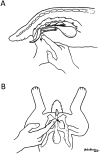Urinary catheterization of male rabbits: a new technique and a review of urogenital anatomy
- PMID: 23562102
- PMCID: PMC3624787
Urinary catheterization of male rabbits: a new technique and a review of urogenital anatomy
Abstract
Rabbits are widely used as an animal model for urologic research studies in which urinary bladder catheterization is required. However, standard manual retrograde urinary catheterization proved to be difficult to perform on anesthetized male rabbits in a research study, with frequent misplacement of the catheter into the vesicular gland. Attempts to reposition the catheter into the bladder after initial entry into the vesicular gland frequently failed and resulted in exclusion of the animal from the study. We assessed the normal anatomy of the lower urinary tract of male rabbits to determine the cause of catheterization misdirection into the vesicular gland and to develop a more reliable technique for urinary bladder catheterization. A modified 'digital (finger) pressure' catheterization technique was developed for successful urinary catheterization of male rabbits. Retrospective statistical analysis of 45 rabbits used for urinary catheterization studies showed improvement in the success rate of catheterization by using the digital pressure technique over the standard method of retrograde urinary catheter insertion. In addition, we here review the relevant gross and histologic anatomy of the urogenital tract of male rabbits.
Figures





Similar articles
-
Collection of untainted urinary specimens from the bladder of an anesthetized rabbit.Lab Anim (NY). 2016 Mar;45(3):112-4. doi: 10.1038/laban.953. Lab Anim (NY). 2016. PMID: 26886657
-
A novel insertion technique for urinary catheters in female dogs with the use of a guidewire.J Vet Emerg Crit Care (San Antonio). 2020 Sep;30(5):597-600. doi: 10.1111/vec.12999. Epub 2020 Aug 31. J Vet Emerg Crit Care (San Antonio). 2020. PMID: 32864846 Free PMC article.
-
Randomized controlled trial to evaluate a novel two-catheter technique for urethral catheterization in anesthetized healthy female cats and small dogs.Am J Vet Res. 2020 May;81(5):448-452. doi: 10.2460/ajvr.81.5.448. Am J Vet Res. 2020. PMID: 32343173
-
Insertion of a urinary catheter.Nurs Older People. 2006 Nov;18(10):33-6; quiz 37. doi: 10.7748/nop.18.10.33.s26. Nurs Older People. 2006. PMID: 17140129 Review.
-
The impact of catheter-based bladder drainage method on urinary tract infection risk in spinal cord injury and neurogenic bladder: A systematic review.Neurourol Urodyn. 2020 Feb;39(2):854-862. doi: 10.1002/nau.24253. Epub 2019 Dec 17. Neurourol Urodyn. 2020. PMID: 31845396
Cited by
-
Determination of Stent Load Conditions in New Zealand White Rabbit Urethra.J Funct Biomater. 2020 Sep 25;11(4):70. doi: 10.3390/jfb11040070. J Funct Biomater. 2020. PMID: 32992694 Free PMC article.
-
International Harmonization of Nomenclature and Diagnostic Criteria (INHAND): Nonproliferative and Proliferative Lesions of the Rabbit.J Toxicol Pathol. 2021;34(3 Suppl):183S-292S. doi: 10.1293/tox.34.183S. Epub 2021 Sep 28. J Toxicol Pathol. 2021. PMID: 34712007 Free PMC article. Review.
-
Collection of untainted urinary specimens from the bladder of an anesthetized rabbit.Lab Anim (NY). 2016 Mar;45(3):112-4. doi: 10.1038/laban.953. Lab Anim (NY). 2016. PMID: 26886657
References
-
- Alexiou C, Jurgons R, Schmid RJ, Bergemann C, Henke J, Erhardt W, Huenges E, Parak F. 2003. Magnetic drug targeting—biodistribution of the magnetic carrier and the chemotherapeutic agent mitoxantrone after locoregional cancer treatment. J Drug Target 11:139–149 - PubMed
-
- Animal Welfare Act as Amended. 2008. 7 USC §2131−2156.
-
- Barlas M. 2002. The effects of piroxicam to the muscosal barrier of the bladder after overdistension—an experimental study in rabbits. Int Urol Nephrol 34:321–324 - PubMed
-
- Csanaky I, Gregus Z. 2002. Species variations in the biliary and urinary excretion of arsenate, arsenite, and their metabolites. Comp Biochem Physiol C Toxicol Pharmacol 131:355–365 - PubMed
Publication types
MeSH terms
Grants and funding
LinkOut - more resources
Full Text Sources
